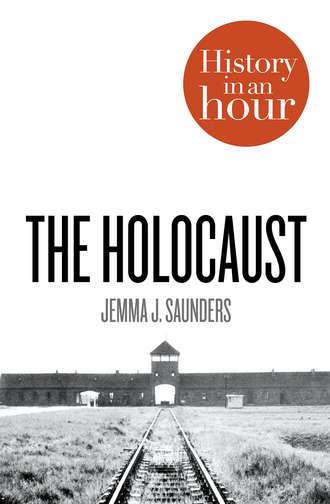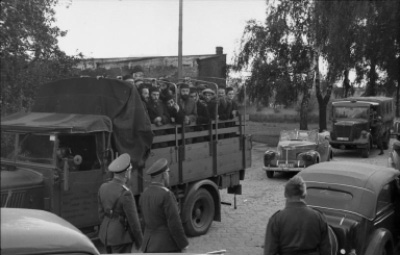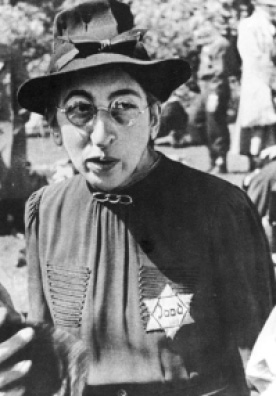
Полная версия
The Holocaust: History in an Hour
Instead, attention turned to Poland, home to over 3 million Jews who, following the invasion, were under Nazi control in the west and Soviet control in the east. These Jews were generally more Orthodox and less assimilated than those in Germany, as they often spoke Yiddish and wore traditional dress.
Large parts of north and west Poland were immediately incorporated into the Third Reich after the outbreak of war, forming a greater Germany. Huge numbers of Jews and Poles from these areas were then forcibly moved from their homes so that Lebensraum would become available for ethnic Germans from other parts of the Reich. The Slavic peoples of Poland and Eastern Europe were, like Jews, considered Untermenschen by the Nazis: racially inferior subhumans.

Arrest and transport of Jews in Poland, September 1939
Bundesarchiv, Bild 101l-380-0069-33 / Lifta / CC-BY-SA
The initial destination of these displaced people was the Generalgouvernement, an area under civil administration situated in central and southern Poland, between the Soviet and Nazi occupied zones. The Nazis transferred an estimated 1 million people to the Generalgouvernement in the early years of the Second World War. From 1 December 1939, all Jews over the age of 10 who lived in this area had to wear a white armband bearing a blue Star of David, making them immediately identifiable. While Poles relocated to the Generalgouvernement were often subsequently assigned labour tasks, Jews were increasingly crowded into designated areas of towns and cities where they were segregated from non-Jewish society: ghettos.
Ghettoization
The internment of Polish Jews in ghettos began in the autumn of 1939. While some ghettos were open, permitting residents to move beyond the boundaries when a curfew was not in place, the majority were closed, with high walls, barbed wire and armed soldiers preventing anyone from leaving. As the Nazi campaign against the Jews twisted towards a policy of annihilation, many ghettos that had previously been open were sealed.
The Warsaw ghetto became the largest in Poland, where 400,000 Jews were crammed into an area of just 1.36 square miles. Such overcrowding was a common feature of ghetto life and several generations of multiple families often lived in one small room, with minimal furnishings.
As fighting continued across Europe, resources in the ghettos became scarce. The official food rations constituted barely 300 calories of sustenance per day, and severe malnourishment or death from starvation was commonplace. Children often foraged beyond the ghetto confines at night for supplies, as they were less likely to be caught than adults. Some used the sewers as a discreet means of moving from one area to another, in search of bread, medicine or weapons. Overcrowding and a lack of basic amenities resulted in filthy conditions both in houses and on the ghetto streets, which in turn led to the inevitable spread of lice and diseases such as typhus.
The Nazis ordered the establishment of Jewish Councils to act as administrative bodies within the ghettos. These Judenräte were usually formed of prominent community figures, often elders, through whom the Nazis disseminated their rules and orders. Demands were habitually made on the Judenräte which had to be met or the consequences would be swift and severe. If the SS ordered that 1,000 gold wedding rings should be handed over by the next day, 1,000 rings would have to be sourced and delivered within the timeframe granted. Refusal to comply could result in death, but collusion with the Nazis at any level weighed heavily on individual consciences. Indeed, some Jewish leaders, such as Adam Czerniakow, committed suicide when asked to compile deportation lists, rather than initiate actions that would send thousands of their compatriots to almost certain death.
Rutka Laskier lived in the Bedzin ghetto and wrote of the horrors she witnessed under the Nazi occupation in her diary, including seeing a German soldier brutally kill a Jewish child. Like many ghetto Jews, Rutka worked for low wages in a local factory. Employment was a fragile safety net, as any Jew deemed ‘unproductive’ was at even greater risk of maltreatment. Aged just 14 when her family was moved from Bedzin’s open ghetto to the closed Kamionka ghetto, Rutka was nevertheless later deported.
Specially commissioned propaganda films and imagery of ghetto life strove to depict Jews as living comfortably in the areas where they has been ‘resettled’. In reality, conditions were cramped, unsanitary and demoralizing. Theresienstadt, in Czechoslovakia, was portrayed as a model ghetto where elderly Jews and Jewish war veterans were sent to retire. In truth, this was another Nazi deception and an estimated 33,000 people still perished there during the war. Like the majority of ghettos in which Jews were interned, Theresienstadt was, for most who were sent there, either their final destination or the penultimate stop on a road to slave labour and death.
West of Germany: Yellow Stars and Registration
Prior to 1942, the experience of Jews in Western Europe was markedly different from that of Jews in eastern countries such as Poland, predominantly because no systematic ghettoization took place to the west of Germany. Each time another western country surrendered to the Nazi war machine, however, the Jews of that nation were subjected to discriminatory measures by the occupying forces. Anti-Semitic legislation was particularly stringently applied in the Netherlands and France, which fell to the Nazis in May and June 1940 respectively.
As had been the case in Germany since the mid-1930s, by the summer of 1942 Jews in the Netherlands and France were banned from cinemas, theatres, swimming pools and even from sitting on park benches. Curfews limited the hours they could spend outside their homes, and restrictions were placed on the shops they could visit, the transport they could use, and the healthcare and education they could receive. Refugees who had fled to these countries in the 1930s, in hope of security and tolerance, were no longer safe from Nazi persecution.

A Jewish lady in Amsterdam wearing a yellow star, 1941
Bundesarchiv, Bild 183-R99538 / CC-BY-SA
Конец ознакомительного фрагмента.
Текст предоставлен ООО «ЛитРес».
Прочитайте эту книгу целиком, купив полную легальную версию на ЛитРес.
Безопасно оплатить книгу можно банковской картой Visa, MasterCard, Maestro, со счета мобильного телефона, с платежного терминала, в салоне МТС или Связной, через PayPal, WebMoney, Яндекс.Деньги, QIWI Кошелек, бонусными картами или другим удобным Вам способом.




